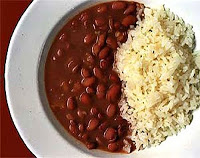There are no reliable statistics to offer concrete numbers, but it’s safe to say that the overwhelming majority of the population of Brazil eats rice and beans (arroz com feijão in Portuguese) every day of their lives. It is the absolute core of Brazilian cuisine and of Brazilian nutrition. Eating rice and beans is not limited to certain geographical regions, nor is it associated with social or economic classes – the ultra-sophisticated “ladies who lunch” in Rio de Janeiro or São Paulo, the subsistence farmers in the Amazon, and the windsurfers along the northeastern coast don’t have a lot in common in many way, but they all eat rice and beans daily.
 Rice and beans, of course, play a large part in the cuisines of many other parts of Latin America – Cuba, Venezuela, Mexico, etc. But it is in Brazil where this combination of an Asian grain (brought to Brazil by the Portuguese) and a native legume (known to the Indians long before the arrival of Europeans) reaches its prime importance. It provides the nutritional basis for the feeding of the nation.
Rice and beans, of course, play a large part in the cuisines of many other parts of Latin America – Cuba, Venezuela, Mexico, etc. But it is in Brazil where this combination of an Asian grain (brought to Brazil by the Portuguese) and a native legume (known to the Indians long before the arrival of Europeans) reaches its prime importance. It provides the nutritional basis for the feeding of the nation.
Rice and beans is eaten by everyone largely by tradition and preference, but also because it is the least expensive way to support human life nutritionally in Brazil. The very poorest Brazilians eat rice and beans and very little else. As one ascends the economic scale the variety of other foods increases, and the amount of nutrition obtained from rice and beans diminishes, but it never drops to zero. Fortunately, besides being inexpensive, rice and beans is a very nutritious dish. It provides protein and carbohydrates, plus iron, vitamin B, calcium, lysine and amino acids. With the addition of a small amount of fruit or vegetable (primarily for vitamin C content) one can survive a lifetime on a diet of rice and beans. Nutritionally, the best proportion is three parts of rice for each part of beans, which are the standard proportions in Brazil.
Regionally, the type of beans used in making this dish varies. In Rio de Janeiro, for example, black beans are favored, while in the northeast a bean similar to Pinto beans is preferred. The rice used, however, is almost universally long-grain white rice. Naturally, if the rice were brown the dish would be nutritionally richer, but long-held custom requires white rice. The rice is steamed or boiled, and the beans are cooked until just soft. The broth for the beans is normally seasoned with at least onion and garlic, plus if economic conditions allow, some form of animal fat or meat – things like bacon, smoked pork, or carne de sol.
Rice and beans, because of their absolute importance in Brazilian nutrition, have become symbolic to most Brazilians of their culture and their lives. The mixture of white rice with brown or black beans is taken to exemplify the racial mixing which is characteristic of Brazil. A well-known Brazilian singer, Daniela Mercury, used this symbolism on the cover of her 1996 album Feijão com Arroz, which was lauded as the best album cover in Brazilian history by an important music magazine. In Brazilian Portuguese, the phrase “arroz com feijão” has come to mean anything that is ordinary or everyday – someone who is looking to change their life might tell their family or friends that they want to get out of this “rice and beans” and find a new life. In actuality, they might find a new life, but they are unlikely ever to get out of the habit of eating rice and beans daily. It’s in the blood. (Source: www.flavorsofbrazil.blogspot.com.br, www.nut-on.blogspot.com.br)